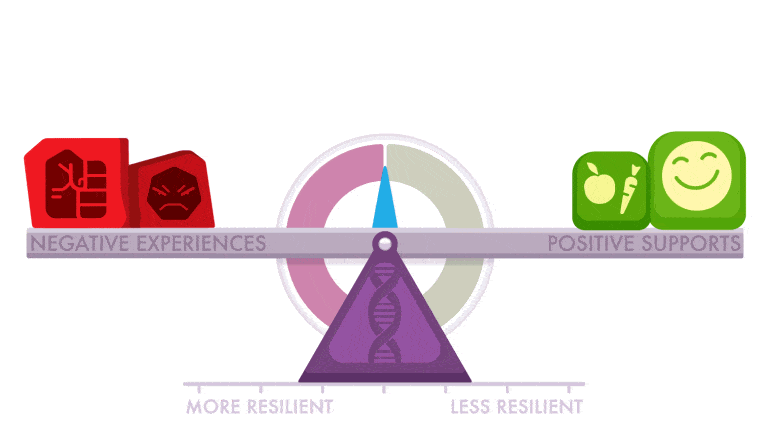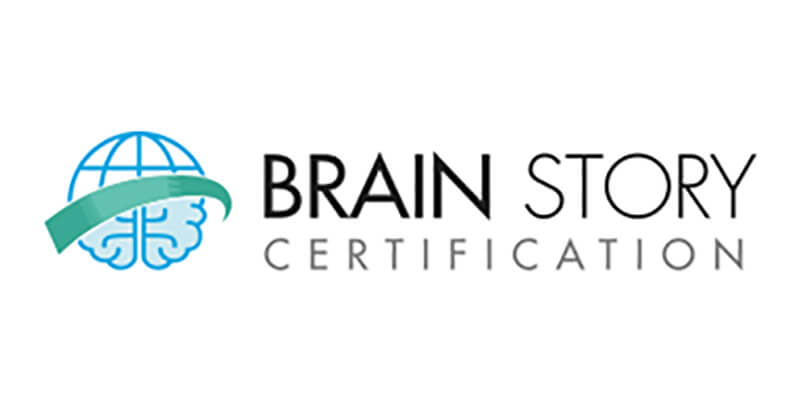Brain Story – Resilience
Even with negative situations present, with enough positives enforcements, long-term positive brain building environments and experiences can be achieved.

TIPPING THE BALANCE TOWARD GOOD HEALTH
To promote a good standard of health and help prevent mental health and addiction problems in our communities, we need to support all individuals in building the foundations of resilience—the skills and abilities that develop through experience and allow us to adapt and stay healthy even in circumstances of severe stress or hardship.
The resilience scale is a metaphor to explain why some people seem more resilient than others and to help visualize how to improve resilience: the ability to respond positively in the face of adversity.
LOADING THE SCALE
Think of a scale where a person’s good and bad experiences get stacked over the course of development. The positive experiences that get stacked on one end are called protective factors and include things like attentive caregivers and available social supports that provide things like good prenatal health, nutrition, health care, and a childhood rich in Serve and Return interactions. The other end of the scale gets loaded up with bad experiences—what scientists call risk factors. These are experiences that cause Toxic Stress and tip the scale in a negative direction. Toxic stress occurs when no caring adults are present to buffer the effects of experiences such as abuse, neglect, or parental addiction.
A person’s resilience scale is a good predictor of health outcomes, and what gets placed on the scale in early childhood is especially important. When the scale, weighed down by positive experiences, tips in a positive direction, a person is more likely to experience good health, academic success, strong relationships, and economic security. A person with a scale weighed down by experiences that cause toxic stress will have increased risk for stress-related diseases, including diabetes, heart disease, anxiety, depression, and addiction. Many of these outcomes surface in adolescence or adulthood, long after the resilience scale was loaded by experiences in early childhood.

SETTING THE FULCRUM
Most of us know of people who seem to thrive in spite of difficult childhoods, or those who struggle in life even though good caregivers and strong communities loaded their scales with predominantly positive experiences.
Experiences alone are only half of the story; genes also play a role. A person’s genetic inheritance is like the starting position of the fulcrum, or the balance point, of the scale: some of us are born highly sensitive to the effects of toxic stress, while others can withstand significant amounts of stress without experiencing lasting harm to brain architecture. On the scale, we see that the position of the fulcrum affects how much leverage positive or negative experiences have in shaping our life outcomes.

HOW DO WE BUILD RESILIENCE?
Research into epigenetics has revealed that, remarkably, the position of the fulcrum is not set in stone. Experiences at critical stages of development modify how our genes are expressed. Over time, supportive relationships and serve-and-return experiences can shift the fulcrum in a more resilient direction, strengthening brain architecture so that a person is better prepared to bounce back from significant life stresses.
Because life events aren’t always in our control, it’s important to help all children build the foundations of resilience so that they can better meet the challenges they may face during development and later in life. For older children, adolescents, and adults, it is never too late to build resilience; though the required effort increases with age, we can always improve skills that enable better outcomes.


Get Brain Story certified!
The Brain Story Certification course is for anyone seeking a deeper understanding of brain development and its consequences for lifelong health. This self-paced online course is free and open to the public. The course is also designed for professionals seeking certification in a wide range of fields and includes 30 hours of instruction time.
References & Sources
- Center on the Developing Child (2013) Innovating in Early Head Start: Can Reducing Toxic Stress Improve Outcomes for Young Children? [Accessed 8/11/2019].
- Crowley, Kevin (2017) Child Development: a practical introduction. London: SAGE Publications Ltd.
- Diamond, A (2013) Executive Functions Annual Review of Psychology, 64: 135-168.
- Franke H.A (2014) Toxic Stress: Effects, Prevention and Treatment. Children, 1(3): 390–402.
- Kendall-Taylor, N and Stanley, K (2018) Seeing Context through Metaphor: Using Communications Research to Bring a Social Determinants Perspective to Public Thinking about Child Abuse and Neglect. International Journal of Environmental Research and Public Health, 15(1): 8-14.
- National Commission on Domestic and Sexual Violence and Multiple Disadvantage (2019) Breaking Down the Barriers (PDF). [s.l.]: National Commission on Domestic and Sexual Violence and Multiple Disadvantage.
- Siegel, D. J. and Bryson, T. P. (2012) The Whole-Brain Child 12 Revolutionary Strategies to Nurture Your Child’s Developing Mind, Survive Everyday Parenting Struggles, and Help Your Family Thrive. London: Robinson.
- Shonkoff, J.P. et al (2004) Young Children Develop in an Environment of Relationships. Cambridge: Center on the Developing Child, Harvard University.
- Shonkoff, J.P. et al (2008) The Timing and Quality of Early Experiences Combine to Shape Brain Architecture Working Paper 5. Cambridge: Center on the Developing Child, Harvard University.
- Shonkoff, J.P., Boyce, W.T. and McEwen, B.S. (2009) Neuroscience, molecular biology, and the childhood roots of health disparities: building a new framework for health promotion and disease prevention, Journal of the American Medical Association, 301 (21), 2252-2259.
- Shonkoff, J.P. et al (2011) Building the Brain’s “Air Traffic Control” System: How Early Experiences Shape the Development of Executive Function Working Paper 11. Cambridge: Center on the Developing Child, Harvard University.
- Shonkoff, J.P. et al (2014), Excessive Stress Disrupts the Architecture of the Developing Brain Working Paper 3. Cambridge: Center on the Developing Child, Harvard University.
- Shonkoff, J.P. et al (2015) Supportive Relationships and Active Skill-Building Strengthen the Foundations of Resilience Working Paper 13. Cambridge: Center on the Developing Child, Harvard University.
- Shonkoff, J.P. et al (2018) Understanding Motivation: Building the Brain Architecture That Supports Learning, Health, and Community Participation Working Paper 14. Cambridge: Center on the Developing Child, Harvard University.
